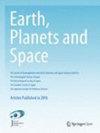The sequence of the 2017–2018 eruptions and seismo-acoustic activity at Kirishima volcano group
IF 2.5
3区 地球科学
引用次数: 1
Abstract
Abstract Kirishima volcano consists of more than 20 eruptive centers. Among them, Shinmoe-dake had magmatic eruptions in October 2017 and March 2018. Subsequently, another active cone, Iwo-yama, had phreatic eruptions in April 2018. These events were unique in that the 2018 eruption was the first effusion-dominated eruption of Shinmoe-dake and the first simultaneous activity of two cones of the Kirishima volcanic group ever documented. We report the detailed sequence of the events by combining areal photos, satellite images, and seismo-acoustic data analyses with the other published information. The seismo-acoustic data clarify the eruption onset and the transitions of the behaviors in three stages for each of the 2017 and 2018 eruptions. For both eruptions, we present regularly repeated tremors or ’drumbeat’ earthquakes in the second stage, which interpret as gas separation from magma, leading to the ash-poor plume in the 2017 eruption or the effusive eruption in the 2018 event. We also propose that the 2017 and 2018 eruptions of Shinmoe-dake and the 2018 eruption of Iwo-yama are sequential events linked by the degassing of magma beneath Shinmoe-dake. An eruption like the 2017–2018 eruptions of Shinmoe-dake would leave few geological records and could be captured only by modern techniques. Although Shinmoe-dake has been believed to be an example of less-frequent eruptions, effusive eruptions like the 2018 case might have occurred more frequently in the past , but the following eruptions had obscured their records. The timelines summarized in this study will be useful in future studies of Kirishima volcanoes and world equivalences. Graphical Abstract雾岛火山群2017-2018年喷发序列和地震声活动
雾岛火山由20多个喷发中心组成。其中,新茂湖在2017年10月和2018年3月发生了岩浆喷发。随后,另一个活火山岩山(Iwo-yama)在2018年4月发生了潜水喷发。这些事件的独特之处在于,2018年的喷发是新茂阁火山第一次以喷出物为主的喷发,也是有记录以来雾岛火山群的两个锥体第一次同时活动。我们通过结合实地照片、卫星图像和地震声学数据分析以及其他已公布的信息,报告了事件的详细顺序。地震声资料阐明了2017年和2018年两次喷发的三个阶段的爆发和行为转变。对于这两次喷发,我们在第二阶段呈现了定期重复的震颤或“鼓点”地震,这被解释为岩浆中的气体分离,导致2017年喷发的灰烬贫乏羽流或2018年事件的喷涌喷发。我们还认为,2017年和2018年的新茂湖火山喷发和2018年的岩山火山喷发是由新茂湖岩浆脱气联系起来的连续事件。像2017年至2018年的新茂湖火山爆发那样的火山爆发将留下很少的地质记录,只有用现代技术才能捕捉到。虽然新茂大火山被认为是不太频繁喷发的例子,但像2018年这样的喷涌式喷发在过去可能发生得更频繁,但随后的喷发掩盖了它们的记录。本研究总结的时间线将对未来雾岛火山和世界等效火山的研究有用。图形抽象
本文章由计算机程序翻译,如有差异,请以英文原文为准。
求助全文
约1分钟内获得全文
求助全文
来源期刊

Earth, Planets and Space
地学天文-地球科学综合
CiteScore
5.80
自引率
16.70%
发文量
167
期刊介绍:
Earth, Planets and Space (EPS) covers scientific articles in Earth and Planetary Sciences, particularly geomagnetism, aeronomy, space science, seismology, volcanology, geodesy, and planetary science. EPS also welcomes articles in new and interdisciplinary subjects, including instrumentations. Only new and original contents will be accepted for publication.
 求助内容:
求助内容: 应助结果提醒方式:
应助结果提醒方式:


